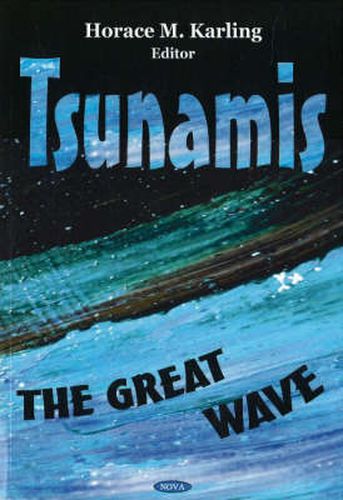Readings Newsletter
Become a Readings Member to make your shopping experience even easier.
Sign in or sign up for free!
You’re not far away from qualifying for FREE standard shipping within Australia
You’ve qualified for FREE standard shipping within Australia
The cart is loading…






The phenomenon called a ‘tsunami’ (soo-NAHmee) is a series of travelling ocean waves of extremely long length generated primarily by earthquakes occurring below or near the ocean floor. Underwater volcanic eruptions and landslides can also generate tsunamis. In the deep ocean, the tsunami waves propagate across the deep ocean with a speed exceeding 800 kilometres per hour (km, ~500 miles per hour), and a wave height of only a few tens of centimetres (1 foot) or less. Tsunami waves are distinguished from ordinary ocean waves by their great length between wave crests, often exceeding a 100 km (60 miles) or more in the deep ocean, and by the time between these crests, ranging from 10 minutes to an hour. As they reach the shallow waters of the coast, the waves slow down and the water can pile up into a wall of destruction tens of meters (30 ft) or more in height. The effect can be amplified where a bay, harbour or lagoon funnels the wave as it moves inland. Large tsunamis have been known to rise over 30 meters (100 ft). Even a tsunami 3-6 meters (m) high can be very destructive and cause many deaths and injuries. Tsunamis are a threat to life and property for all coastal residents living near the ocean. During the 1990s, over 4,000 people were killed by 10 tsunamis, including more than 1000 lives lost in the 1992 Flores region, Indonesia, and 2200 lives in the 1998 Aitape, Papua New Guinea tsunamis. Property damage was nearly one billion United States (US) dollars. Although 80% of the tsunamis occur in the Pacific, they can also threaten coastlines of countries in other regions, including the Indian Ocean, Mediterranean Sea, Caribbean region, and even the Atlantic Ocean.
$9.00 standard shipping within Australia
FREE standard shipping within Australia for orders over $100.00
Express & International shipping calculated at checkout
The phenomenon called a ‘tsunami’ (soo-NAHmee) is a series of travelling ocean waves of extremely long length generated primarily by earthquakes occurring below or near the ocean floor. Underwater volcanic eruptions and landslides can also generate tsunamis. In the deep ocean, the tsunami waves propagate across the deep ocean with a speed exceeding 800 kilometres per hour (km, ~500 miles per hour), and a wave height of only a few tens of centimetres (1 foot) or less. Tsunami waves are distinguished from ordinary ocean waves by their great length between wave crests, often exceeding a 100 km (60 miles) or more in the deep ocean, and by the time between these crests, ranging from 10 minutes to an hour. As they reach the shallow waters of the coast, the waves slow down and the water can pile up into a wall of destruction tens of meters (30 ft) or more in height. The effect can be amplified where a bay, harbour or lagoon funnels the wave as it moves inland. Large tsunamis have been known to rise over 30 meters (100 ft). Even a tsunami 3-6 meters (m) high can be very destructive and cause many deaths and injuries. Tsunamis are a threat to life and property for all coastal residents living near the ocean. During the 1990s, over 4,000 people were killed by 10 tsunamis, including more than 1000 lives lost in the 1992 Flores region, Indonesia, and 2200 lives in the 1998 Aitape, Papua New Guinea tsunamis. Property damage was nearly one billion United States (US) dollars. Although 80% of the tsunamis occur in the Pacific, they can also threaten coastlines of countries in other regions, including the Indian Ocean, Mediterranean Sea, Caribbean region, and even the Atlantic Ocean.